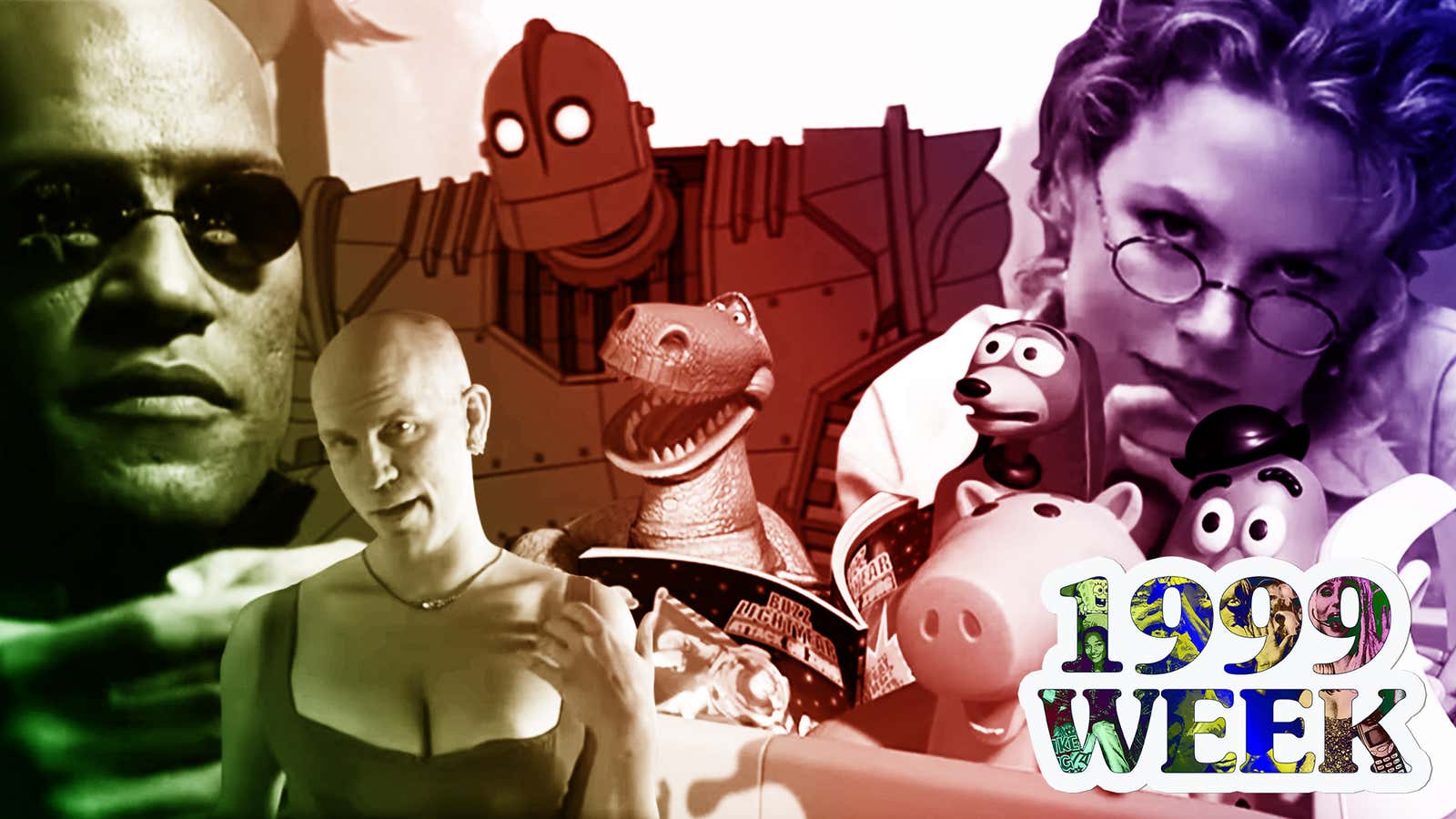
Back in the spring, author and journalist Brian Raftery amplified an increasingly popular opinion of contemporary film culture. As the title of his book teases, Best. Movie. Year. Ever.: How 1999 Blew Up The Big Screen entertains the possibility that cinema—or at least American cinema—may have peaked in ’99, which now gets regularly cited alongside 1939 and 1974 whenever someone raises the question of which single year, exactly, is Hollywood’s greatest. It wasn’t like movie-lovers and critics didn’t know they were experiencing something major, a true bumper crop, while it was happening. But in the two decades since, ’99’s reputation has only grown, to the point where it’s now frequently treated as a kind of mini-renaissance: an unexpected rush of wall-to-wall classics, all released on the cusp of the new millennium.
If 1999 isn’t, as many now insist, the best movie year, it’s almost certainly one of the most movie years. To scan the ’99 release calendar is to encounter one important, groundbreaking film after another. It gave us the final work by a reigning master, and debuts by masters in the making. It delivered arguably the most anticipated franchise extension in movie history, and also one of the most profitable movies of all time, a low-budget horror sensation that rode word of mouth to big box office (and maybe bigger backlash). It was a watershed moment for teen comedies, animated features, and special-effects blockbusters. And for all the talk of great American movies, plenty of terrific international cinema—from Japan, Iran, and elsewhere—made a splash.
When it came time to rank our favorites of 1999, The A.V. Club laid down some ground rules, similar to the ones that governed our rundowns of 1997 and 1998’s best, as well as our annual critic poll. To qualify for inclusion, a film had to be released in America sometime in ’99. That meant excluding certain films that only premiered that year—including, unfortunately, some great work by female directors, who had to fight even more then than they do now to get movies made and seen. (Check back in a year, when we’ll surely be singing the retrospective praises of The Virgin Suicides, Beau Travail, Ratcatcher, and But I’m A Cheerleader, all of which made it into U.S. theaters in 2000.) It also meant making room for films, many of them not American, that found their way to America in ’99—though we narrowed the eligibility window to five years, which is why you won’t find, say, the 1990 masterpiece Close-Up on the list below. This is, after all, the Best. Movie. Year. Ever. We had to narrow the field somehow.
25. Boys Don’t Cry
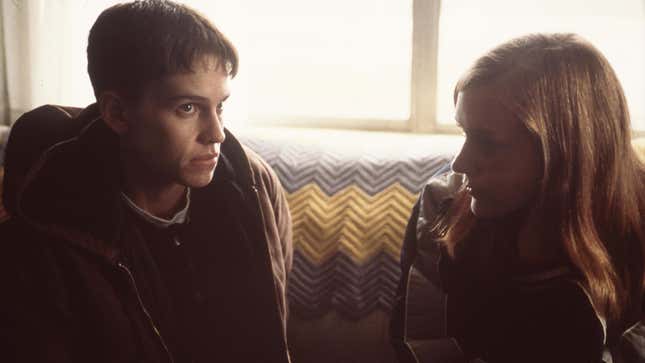
More so than most of the other movies on this list, Boys Don’t Cry feels like a product of a different time. Even the most glowing contemporaneous reviews couldn’t get the pronouns right (they were heavy on deadnaming and talk of “gender confusion”), and elements of the film itself—including having a cis woman, Hilary Swank, play a trans man—are pretty dated, too. All the same, there’s undiminished, howling empathy to Kimberly Peirce’s ripped-from-the-headlines drama about Brandon Teena, who was raped and murdered by acquaintances when they discovered he was transgender. Though Boys Don’t Cry builds, with gut-wrenching inexorability, to Brandon’s death, it’s every bit as sincerely interested in envisioning what his life might have looked like—in investigating his dreams, his rebellious spirit, and how he navigated the rural Nebraska of 1993. And though the casting may look like a mistake from the vantage of our marginally more enlightened now, Swank’s Oscar-winning performance retains its vitality and power, conveying the adrenaline rush of being who you really are, no matter the risk. [A.A. Dowd]
24. Perfect Blue
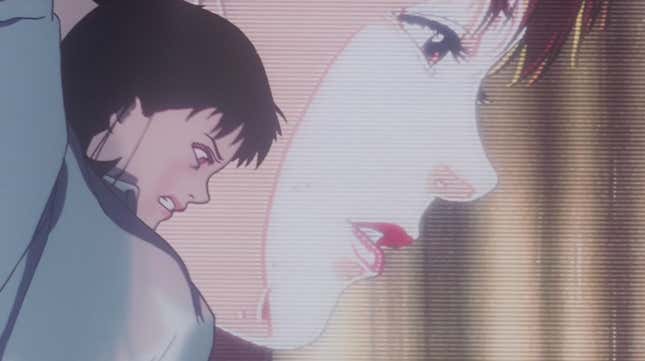
Before screens became such a ubiquitous part of our daily lives, before catfishing had its own MTV show, and before movies like Cam and Unfriended picked up on the internet’s menacing, psychologically distorting potential, there was Satoshi Kon’s directorial debut, Perfect Blue. Following Mima, a former pop star plunged into the rabbit hole after discovering a fan blog manned by an unhinged and obsessive host, the film peels back into a hellscape interrogation of celebrity, self-image, and privacy in the digital age. Considered one of Darren Aronofsky’s biggest inspirations (Black Swan, with its evil doppelgänger and ballerinas, is practically a rip-off), this animated masterpiece unfolds through sharp and fluid editing as it descends into goosebump-inducing surrealism. And as a story of what its like to inhabit a woman’s body, it pulls no punches; this might very well be the film Vox Lux wishes it was. [Beatrice Loayza]
23. American Movie
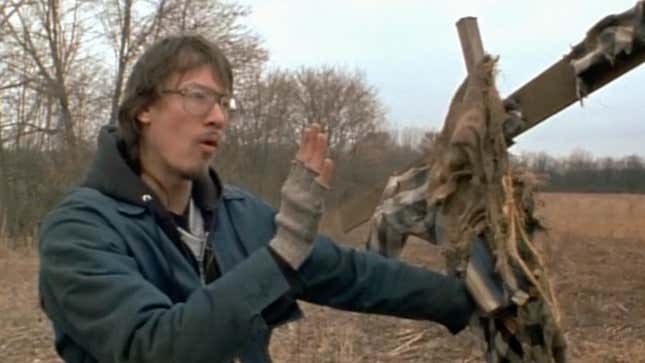
Of course most Hollywood studio movies are about pursuing and attaining your dreams; they’re written by professional screenwriters, people who have already completed their years of struggling and come out on top. An uncompromised paean to striving and failure like American Movie could only come from the no-budget independent fringes, where we find quixotic autodidacts like DIY filmmaker Mark Borchardt. Chris Smith’s Sundance-winning documentary follows the semi-skilled director, debt magnet, and alcoholic-in-training on the harried production of his self-financed horror picture Coven, which Borchardt sees as the stepping stone to the movie he really wants to make. First, though, he’ll have to overcome the limits of his own talents, a crew made up of untrained incompetents volunteering their time, a prohibitively finite budget, and a script that just won’t hold together. American Movie dares to wonder at what point a person should accept that their life’s aspiration simply ain’t happening, and in truly American fashion, concludes that all the financial ruin and self-destruction in the world can’t keep a person from a sense of purpose. Borchardt’s own movies may have been ramshackle operations, but this one is—to put it in his words—kick-fuckin’-ass. [Charles Bramesco]
22. The Iron Giant
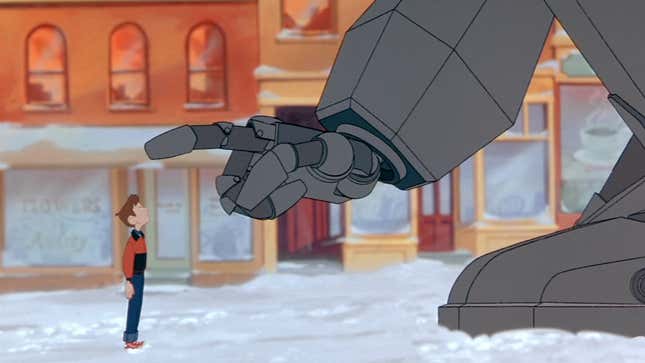
In one way, The Iron Giant couldn’t be simpler; it’s made of familiar stuff, including a kid befriending a strange visitor, grownups not understanding (except when they do), and bravery and empathy as superpowers. On the other hand, Brad Bird’s exceptional animated debut is unafraid to wade into the muck of some big, dark material: violence, paranoia, greed, recovery from trauma, the list goes on. The Iron Giant, voiced by a young Vin Diesel, has the ability to rebuild himself when he’s broken—a metaphor as powerful as the revulsion the towering robot inspires. As much as Bird understands that fear, he also grasps why Hogarth—ostracized by his classmates, small and smart with a funny name and love for the lonely—would see what the title wonder really is before anyone else. It’s a great kids’ film, a triumph of animation (both traditional and computer-generated), and above all, a potently compassionate fairy tale. Plus, the giant robot is really cool. [Allison Shoemaker]
21. Autumn Tale
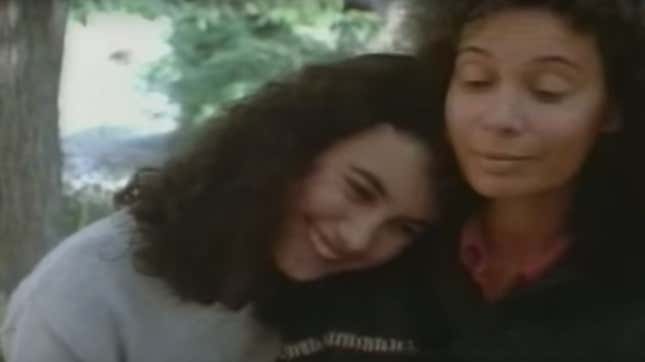
The fourth and final installation in Eric Rohmer’s “Tales Of The Four Seasons” cycle, Autumn Tale would seem to be a romantic relic in the landscape of edgy teen comedies and all-American Nora Ephron movies that distinguished the late ’90s. But though Rohmer preserves his decades-running penchant for chatty and witty dissections of ordinary people, he throws a curveball by centering the story not on young people, his usual subjects, but on the inner lives of women in their 40s. Featuring two of his former collaborators, Béatrice Romand and Marie Rivière, the film tinkers with magical realism as it draws parallels between the beautifully ripened women and the resplendent vineyard that one of them settles into as her solitary haven. A late-career entry into the Rohmerian canon, this thoughtful, leisurely exploration of midlife anxiety and suspended desire is a convincing argument for the timeless appeal of the filmmaker’s seductive naturalism. [Beatrice Loayza]
20. After Life

Last year, Kore-eda Hirokazu won the most prestigious film prize in the world, the Palme D’Or at Cannes, for his domestic drama Shoplifters. The movie’s delicate humanism was no surprise to anyone who’s followed the Japanese director’s career over the years—and especially not to those who have seen his thoughtful, moving second feature. After Life envisions the world beyond death as a kind of banally decorated administrative building, where a team of celestial caseworkers help the recently deceased make an important decision: What memory from their bygone lives would they like to carry with them to heaven and relive for all of eternity? In this simple prompt, Kore-eda finds a rich vein of philosophical inquiry, gently offbeat workplace comedy (NBC’s The Good Place contains perhaps accidental echoes of its bureaucratic vision of the afterlife), and even a metaphor for filmmaking itself as an imperfect but valuable way to process, immortalize, and make sense of experiences. One could say Kore-eda’s laurels were overdue; he earned them 20 years ago, with a meditative delight that’s held up as well as a forever-cherished memory. [A.A. Dowd]
19. The Insider
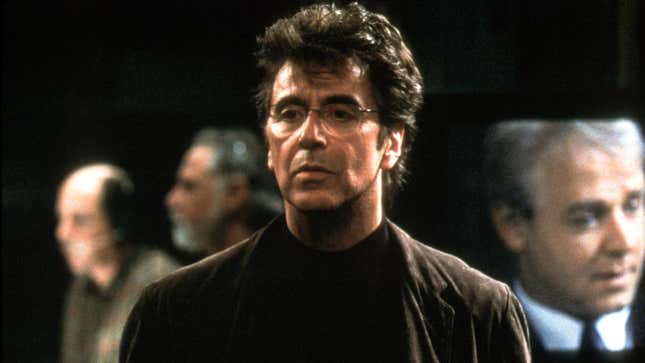
When director Michael Mann and co-writer Eric Roth told the behind-the-scenes story of a controversial 60 Minutes segment, they were really delivering a warning about some alarming trends in the American media—a warning the public has largely failed to heed. Al Pacino gives one of his best late-career performances, more muted and less shouty, as Lowell Bergman, a producer who chases down a scoop regarding previously unknown smoking hazards. Russell Crowe plays The Insider’s insider, the tobacco-industry whistleblower Jeffrey Wigand, whose personal problems—and his non-disclosure agreements—give his former bosses the weapons they need to try to intimidate CBS News. What emerges is a disturbing portrait of two corporations effectively conspiring to bury the truth, because money and power matters more than the citizenry learning about how they’re being poisoned. [Noel Murray]
18. Three Kings
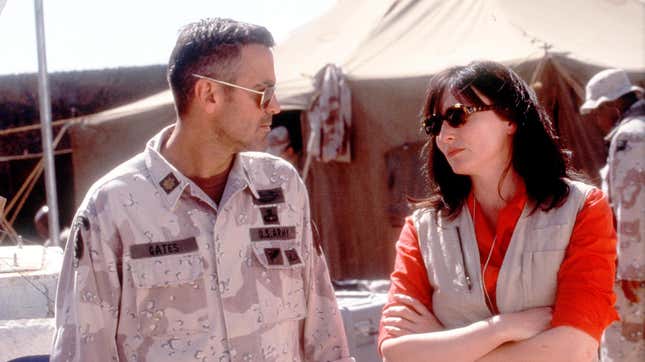
Although David O. Russell started his career with a transgressive indie, there’s something unconvincing about the recent charges that he’d sold out with star-powered Oscar bait. After all, most of Russell’s movies tell accessible stories—farce, underdog sports, romance—through quarrelsome characters and a restless camera. To that end, his third feature, Three Kings, may be his deftest feat, a post-war war movie and a heist picture where a gold theft orchestrated by a quartet of Gulf War soldiers (George Clooney, Ice Cube, Mark Wahlberg, and Spike Jonze, forming an improbable chemistry) is hijacked by their compulsion to do what’s right. The bleachy, blown-out cinematography makes this Russell’s most stylistically adventurous film, as well as one of his most purely entertaining—like a darkly funny, less bombastic Oliver Stone project. A few years later, real life would mount a more expensive, more catastrophic sequel to the Gulf War, and Three Kings’ depiction of America’s role in Middle Eastern turmoil would feel both more resonant and, in its smaller scale, a little quaint. [Jesse Hassenger]
17. Bringing Out The Dead
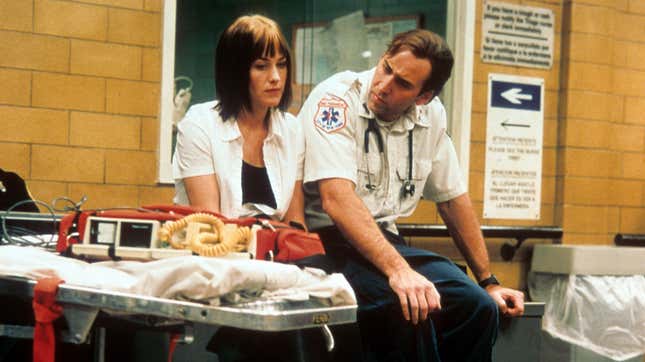
Martin Scorsese’s last film of the ’90s brought him back to familiar territory: a lonely insomniac driving around Manhattan, this time in an ambulance, carrying the horrors of the world on his shoulders. But Bringing Out The Dead has a much more generous spirit than the director’s ’70s masterpiece, carving out space for forgiveness within an indifferent landscape. In one of his finest performances, Nicolas Cage plays paramedic Frank Pierce (a kinder, benevolent version of Travis Bickle), who walks through the world in a daze, haunted by the lives he couldn’t save. He moves through writer Paul Schrader’s eminently specific world of EMTs and hospital workers who shrug off their low success rate—a foreign concept to a man who takes every death personally. Featuring one of Scorsese’s best soundtracks and a bevy of great supporting talent, Bringing Out The Dead boasts a poignancy that sneaks up on you, often in moments when you least expect it, e.g., Frank convincing a suicidal man to accompany him to the hospital where they’ll kill him for free. Compassion comes in many forms. [Vikram Murthi]
16. All About My Mother
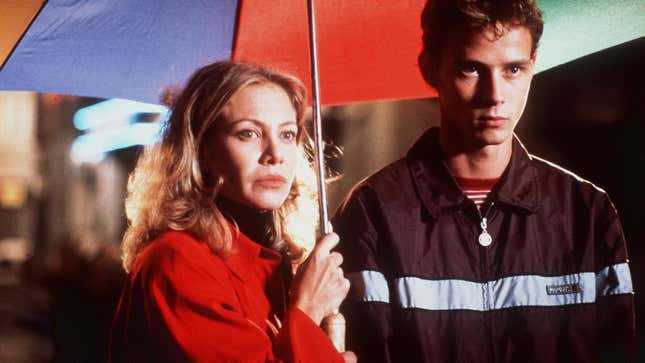
“I’m every woman, it’s all in me,” sang Chaka Khan. Pedro Almodóvar likewise sees femininity as a vessel for just about everything meaningful in life: purity and sin, sex and sainthood, passion and decay. When Cecilia Roth’s Manuela leaves her job as an organ-transplant nurse to go tell her ex in Barcelona that their son has died, she makes the acquaintance of several women who appear to her like variations on a theme: a pregnant nun (Penélope Cruz), a lively sex worker (Antonia San Juan), a haughty actress (Marisa Paredes), a lesbian addict (Candela Peña), and her former spouse (Toni Cantó), who’s since come out as trans and now goes by Lola. Each contains a dimension of womanhood filtered through the humid melodrama of Douglas Sirk and the cocked-eyebrow wit of the camp classic alluded to in the title. Almodóvar had by that point earned global respect as a profane rascal, but a newly reined-in but no less vivacious style, along with enlightened ideas about gender and the AIDS epidemic, kicked off a new era of vibrant discipline for the artist. [Charles Bramesco]
15. Fight Club
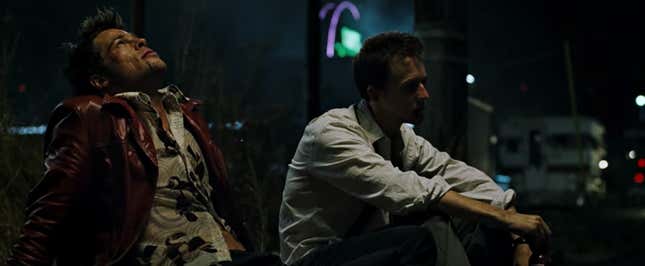
Since basically flopping at the box office, Fight Club has been widely misinterpreted as a sincere glorification of male violence. That reading misses the point of David Fincher’s adaptation of the satirical Chuck Palahniuk novel, which addresses legitimate concerns about culture commodification, cannibalistic capitalism, and increasing social isolation but ultimately argues we shouldn’t give into our darkest impulses when trying to change the world. Edward Norton’s wonderfully unhinged performance meets its match in Brad Pitt, who brings gleeful mania to Tyler Durden’s personified id. The push-pull magnetism between the pair adds emotional depth to scenes that masquerade as mere masculine posturing, and Helena Bonham Carter’s Marla Singer, with her own brand of anti-establishment survivalism, is the film’s secret weapon. Those performances, combined with the Dust Brothers’ trippy score and Fincher’s customarily confident visual flair (bringing the IKEA catalog to life with the rhythmic population of Norton’s apartment, for example), cemented Fight Club as a cult classic to be feverishly consumed (and misunderstood) for years to come. [Roxana Hadadi]
14. The Straight Story

“David Lynch does Disney,” as one might offhandedly describe The Straight Story, sounds like a recipe for disaster. But break down the fundamental elements of the director’s only G-rated film, and the combination doesn’t seem so strange. Here are the small towns, the little routines, the unavoidable specter of mortality, and the admiration of resilience that characterize much of Lynch’s work—as well as, honestly, the Mouse House’s. Here is the familiar, uncanny softness of Angelo Badalamenti’s score, and the moments of humanity, simple but precious to characters and filmmaker alike. And above all, here is the great Richard Farnsworth, playing Alvin Straight, a man who really did drive a lawnmower hundreds of miles to see his ailing brother. Farnsworth’s face is a map of a life; when he smiles, one aches. Both Farnsworth and The Straight Story are a lot like Straight’s trip to Wisconsin, come to think of it: unexpected, straightforward, and special. [Allison Shoemaker]
13. The Sixth Sense
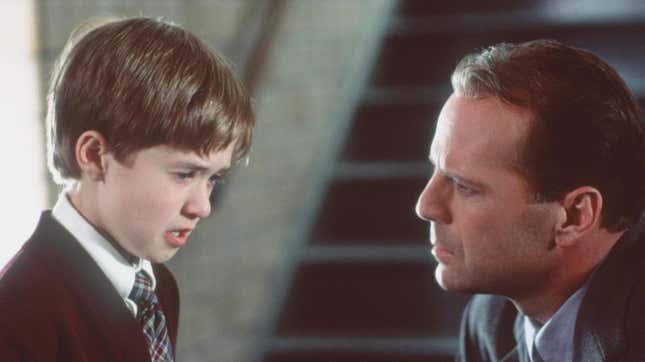
“I see dead people” is a line that remains clamoring around the pop culture consciousness 20 years later, but the impact of M. Night Shyamalan’s big breakthrough as a writer and director is greater than that. Bruce Willis’ increasingly self-aware performance as psychologist Malcolm Crowe was a refreshing change of pace for the actor; Haley Joel Osment gripped viewers with his deeply felt terror as pint-sized medium Cole Sear; and Shyamalan’s twist ending gave the filmmaker his calling card. The film derives its power primarily from its questions about the responsibilities of the living and the regrets of the dead, and its unexpected reveal only elevated that duality. Although Shyamalan would return too often to this gotcha brand of storytelling, The Sixth Sense effectively took viewers on a journey from external dread to internal horror, helping usher in a revival of methodically tense, Victorian-style ghost stories, including Nicole Kidman’s The Others, a solid chunk of Blumhouse’s oeuvre, and Mike Flanagan’s House On Haunted Hill. [Roxana Hadadi]
12. Princess Mononoke
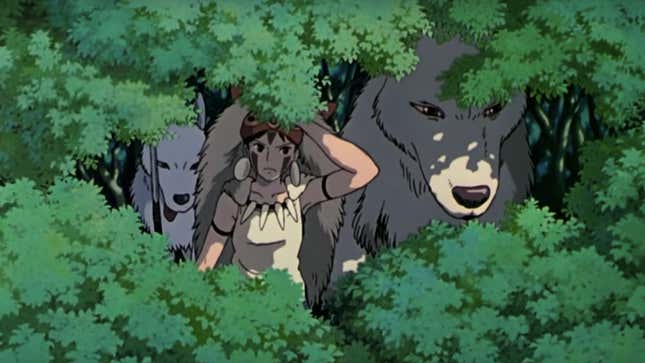
When it finally surfaced Stateside two years after its record-breaking run in Japan, Princess Mononoke didn’t have the kind of success that Disney/Miramax, its U.S. distributor, might have hoped for. But there’s no question that this Studio Ghibli film, helmed by legendary animator Hayao Miyazaki, possesses the heft, grandeur, and epic scope to match—or indeed better—just about any blockbuster released in 1999. Set during Japan’s Muromachi period, the film observes as the last Emishi prince becomes drawn into a violent conflict for the future of a forest threatened by destruction. The film’s eco-fable elements are clear enough, but the story—imaginatively drawn from Japanese mythology and folklore—is politically and morally complex nonetheless, augmented at every turn by the animation’s visual splendor and sheer kineticism. Three years later, Miyazaki’s follow-up, Spirited Away, would take home the Academy Award for Best Animated Feature, but Princess Mononoke was the arrow that pointed the way forward. [Lawrence Garcia]
11. The Limey

Steven Soderbergh’s follow-up to his sleek, sexy mainstream breakthrough was another crime film, only this time he traded kicky fun for a semi-Proustian meditation on regret. A downbeat revenge thriller populated by character actors and a ’60s legend, The Limey has the infrastructure of a Point Blank but the heart of a Hiroshima, Mon Amour. Sarah Flack’s fractured editing style, Lem Dobbs’ sharp script (famously pared down to its bare essentials by Soderbergh), and Ed Lachman’s sun-drenched photography create a memory film whose structure resembles a ruined life flashing before one’s eyes. Terence Stamp, equally menacing and penitent, determinedly stalks Los Angeles to avenge his dead daughter, but his vengeance mostly underscores his own past mistakes. Despite its rueful emotional register, The Limey still embraces a relaxed California vibe, one that permeates the melancholy with nostalgic monologues and crass wisecracks. Soderbergh closed out his first working decade with a towering achievement, one driven by a collaborative spirit and a craftsman’s eye. Thank god they’re still fucking coming. [Vikram Murthi]
10. Topsy-Turvy
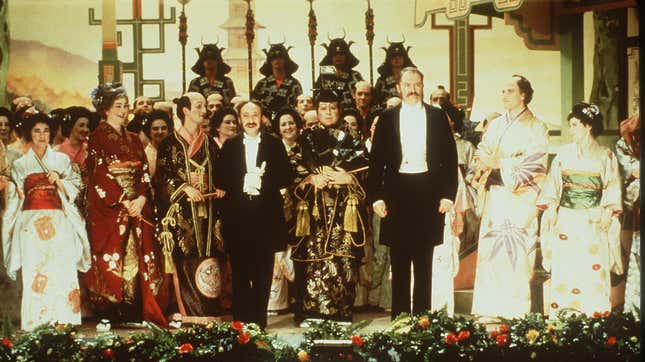
At the time best known for his portraits of contemporary working-class British life, Mike Leigh first ventured into period-drama territory with this vividly detailed chronicle of Gilbert and Sullivan putting on The Mikado, one of the Victorian-era duo’s most successful operettas. A rare depiction of artistic process from the writer-director (Mr. Turner would follow 15 years later), Topsy-Turvy assembles a sprawling ensemble cast of Leigh regulars like Jim Broadbent, Lesley Manville, and Timothy Spall, each vibrant and memorable. The film’s greatness, though, lies in Leigh’s deft orchestration of contrapuntal tones, mixing exhilaration and exhaustion, elation and resignation, sadness and joy with seemingly effortless flair—not to mention a number of varied, hilarious musical performances. At once a moving paean to creative pursuit and a sobering look at its limits, Topsy-Turvy captures the veritable chaos of the artist life like few films have managed. It’s the world turned upside down. [Lawrence Garcia]
9. The Blair Witch Project
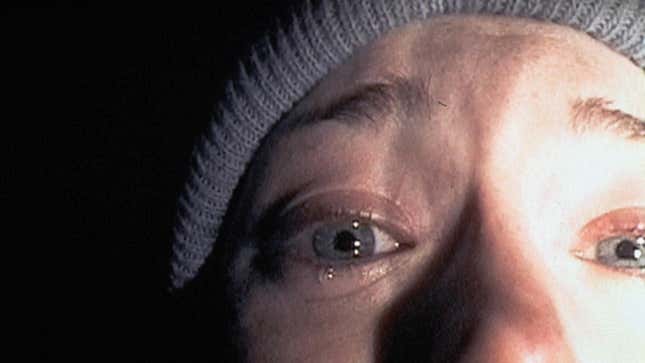
The film that launched a thousand arguments, not to mention an entire horror subgenre that’s still going strong 20 years later. At the time, people were ready to believe that they’d be watching actual recovered footage from three young people who’d mysteriously disappeared; American audiences descended on theaters in droves (adjusted for inflation, it grossed about $215 million, roughly the same as Mission: Impossible—Fallout or Ant-Man And The Wasp), with many people emerging 81 minutes later absolutely livid at the absence of anything overtly terrifying. Ignore the hype, however, and The Blair Witch Project is bone-chilling in a different way—more akin to Sartre’s No Exit than to The Exorcist. Improvising in the woods for several days, the three lead actors inevitably start to turn on each other, achieving levels of frustration and resentment that would be nearly impossible for amateurs to fake. (Try to get Heather Donahue’s famous snot-nosed apology from an actor who’s just come from the craft service table.) The bogeyman here isn’t the never-seen Blair Witch. It’s human nature itself. [Mike D’Angelo]
8. Toy Story 2

Toy Story 3 and Toy Story 4 have both been widely praised for grappling with serious existential questions, investing what are ostensibly kids’ movies with genuine emotional depth. But it was the franchise’s second entry—only Pixar’s third feature overall, after the original Toy Story and A Bug’s Life—that laid the groundwork for subsequent explorations of creeping obsolescence and time’s indifferent arrow. Here, nobody’s faced with or seeking oblivion; instead, Woody, stolen by a collector, discovers his storied past, meets forgotten friends, and is faced with a difficult decision: allow himself to be rescued by Buzz and the gang (eventually to be discarded by Andy), or become a treasured display in a Japanese museum? Toy Story 2 finds the ideal balance between poignant and hilarious, even briefly achieving both at once when Buzz encounters a still-delusional doppelgänger. Plus, Jessie’s flashback rivals Up’s prologue as Pixar’s most downright ruthless tearjerker. Not bad for a sequel that was originally intended strictly for home video. [Mike D’Angelo]
7. Election

Who would’ve thought that one of the truest and funniest movies ever made about politics would be set at an Omaha high school? Director Alexander Payne and his writing partner Jim Taylor adapted Tom Perrotta’s novel of the same name into an unsparing satire, where nearly every character is at once painfully familiar and overtly ridiculous, from the perky, soulless overachiever Tracy Flick (Reese Witherspoon), who’s running for student council president, to the self-righteous, hypocritical social studies teacher Jim McAllister (Matthew Broderick), who convinces himself that by sabotaging Tracy’s campaign he’ll actually be making a real difference in the world. The plot’s petty stakes only make Election more stinging. When McAllister tries to illustrate the importance of the democratic process by comparing apples to oranges—and then drawing identically featureless circles on a chalkboard—it’s hard to imagine a more brutal depiction of how American elections usually go. [Noel Murray]
6. A Moment Of Innocence
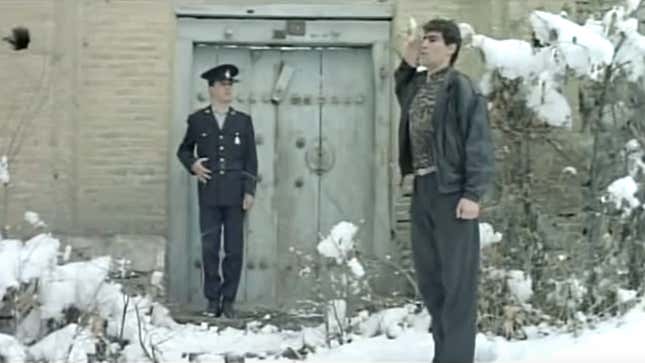
Abbas Kiarostami ultimately became the torchbearer for Iranian cinema in the West, but back in the ’90s, Mohsen Makhmalbaf was considered every bit his equal. (They even collaborated, in a way: Kiarostami’s Close-Up is about a Makhmalbaf impersonator.) A Moment Of Innocence, Makhmalbaf’s masterpiece, sees him transform a shameful incident from his youth—he’d stabbed a policeman during a political protest—into something deeply and unexpectedly cathartic. Hiring an actor to play his teenage self, he persuades the officer he’d assaulted (also played by an actor, but the film deliberately blurs these lines) to participate in a filmed re-creation. “You say you want to make the world better?” Makhmalbaf asks his avatar, trying to get him in the correct headspace. “Then you have to stab, stab!” But neither the fake culprit nor the actual victim feels comfortable with these destructive emotions, and the movie gradually builds to an abrupt repudiation that’s among the most gorgeously hopeful moments the movies have ever produced. [Mike D’Angelo]
5. Magnolia
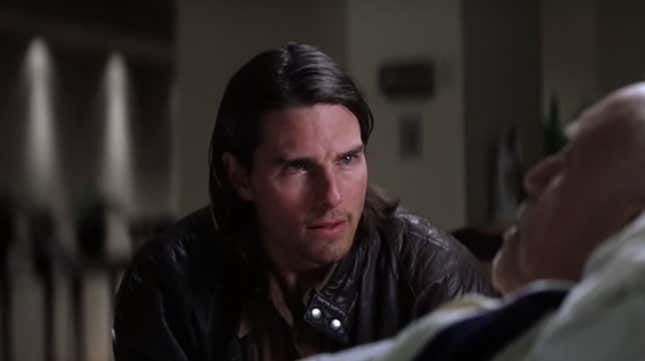
Magnolia is not the tightest or most restrained movie writer-director Paul Thomas Anderson has made. By most accounts, including the director’s own, it’s probably the least disciplined: an operatic tribute to his hometown of Los Angeles, his idol Robert Altman, and his sprawling cast, among other things. But while the control Anderson would subsequently bring to his later work is admirable, it also makes the open-hearted intensity of Magnolia feel fleeting and precious, a marathon of foolhardy young-person swings, from Ricky Jay-narrated anecdotes to cross-cut Aimee Mann sing-alongs to raining frogs. As heavy as Anderson’s hand may feel in the movie’s technical and storytelling flourishes, it might not have worked without that roster of top-notch performances, varying in tone and tempo: the heartbreaking sweetness of John C. Reilly, the frayed nerves of Melora Walters, the crumbling bravado of Tom Cruise, and on and on. “And on and on” also describes the experience of watching Magnolia, a tapestry that doesn’t stop unfurling until that perfect final shot. [Jesse Hassenger]
4. The Talented Mr. Ripley
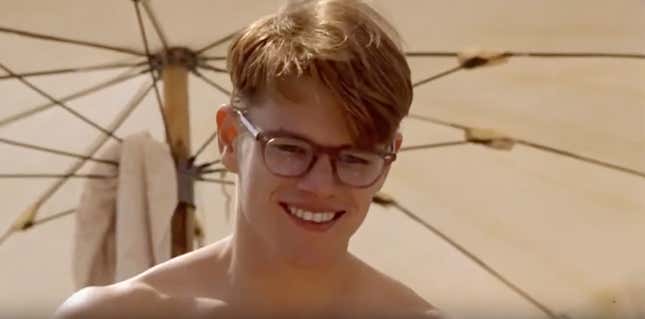
The late Anthony Minghella was never a fashionable director, but he produced at least one classic with this intelligent, suspenseful adaptation of the first novel in Patricia Highsmith’s Tom Ripley cycle. Neither the first nor the last film on this list to deal in identity games, social masquerades, and thwarted desire, The Talented Mr. Ripley stars Matt Damon (in one of his best performances) as the title character, a part-time pianist who is recruited by a tycoon to track down his wayward son (Jude Law) in Italy, and quickly ingratiates himself into his life and social circle. In a stark departure from the source material, Minghella transforms Highsmith’s cold-blooded master con into a tragic chameleon; we sympathize with his desperation and gut-wrenching insecurity even as the charade turns deadly. With its sparkling 1950s atmosphere and terrific supporting cast (including such burgeoning stars as Gwyneth Paltrow, Cate Blanchett, and Philip Seymour Hoffman), Ripley has only gotten better with age. [Ignatiy Vishnevetsky]
3. The Matrix

In the wake of Lana and Lilly Wachowski’s respective comings-out as trans women, critical opinion on their game-changing hit The Matrix has coalesced into reading it as a metaphor for its creators’ transgender identity. And the thing is, that interpretation totally tracks. All of the Wachowskis’ work deals with themes of identity, but The Matrix makes explicit the techno-utopian ideal of the mind—and the internet!—as vehicles for transcending the limitations of the human body. But even without this radical subtext, the influence The Matrix has had on every action and sci-fi film made in its wake is difficult to overstate. And it’s not just the film’s oft-imitated “bullet time” technique or cyber-goth aesthetic that made an impact: Featuring “wire-fu” effects and martial arts choreographed by the legendary Yuen Woo-ping, The Matrix brought the union of Hong Kong action aesthetics and American blockbuster filmmaking to its kickass culmination. It also launched the career of future John Wick director Chad Stahelski, who’s since evolved from serving as Keanu Reeves’ stunt double to directing Reeves in a whole new wildly successful action franchise. It seems safe to say that this was a transformative film all around. [Katie Rife]
2. Eyes Wide Shut

Deceptively marketed as an erotic thriller, Stanley Kubrick’s confounding, posthumously released final film takes the pessimistic maestro’s career-long fascination with male ego and insecurity to strange places. A successful Manhattan doctor (Tom Cruise) sets off on the Kafkaesque odyssey to cheat on his wife (Nicole Kidman) after she admits to having once fantasized about an affair; along the way, he stumbles upon a secret society of the rich and powerful. The fastidious artificiality of the film, which still holds the record as the longest continuous shoot in Hollywood history, only adds to the overwhelming, unresolvable dream logic. The result is, in some ways, as much of a head trip as 2001: A Space Odyssey, slipping from paranoia (about sex, relationships, and plutocracy, among other things) into black comedy; while Cruise’s Kubrick-referencing turn as the pick-up guru in Magnolia may have more pyrotechnic moments, this is the performance that really subverts his star power. But speaking of weak-willed men stuck in the nightmare of their desires… [Ignatiy Vishnevetsky]
1. Being John Malkovich
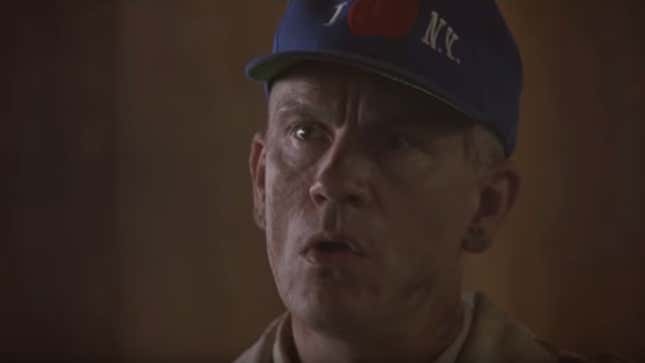
Twenty years ago, just about everyone could agree that Being John Malkovich was the most original, bizarre, madly inventive movie of the year. No one had ever seen anything like it. Truthfully, age has only underscored the singularity of the film’s cracked daydream ambition, which looks all the more miraculous when held against the reboot redundancy of modern Hollywood. Shaking off the shackles of network-sitcom duty, screenwriter Charlie Kaufman offered the first of his big-screen high concepts, spinning the funny-morose tale of a puppeteer (John Cusack, bravely unlikable in a career-high performance) whose attempts to cheat on his wife (Cameron Diaz) with a co-worker (Catherine Keener) are suddenly complicated by an unlikely discovery: a portal hidden behind a filing cabinet that leads straight into the brain of Hollywood actor John Malkovich, playing himself. The mix of gut-busting surrealism (seriously, this thing boasts about a laugh a minute) and neurotic psychodrama would become a hallmark of Kaufman’s one-of-a-kind work. But the film also kicked off the parallel (and sometimes intersecting) movie career of his collaborator, the deliriously gifted music-video director Spike Jonze, whose talent for madcap orchestration keeps the whole crazy project afloat. Beyond introducing the world to two kindred spirits in soulful bug-fuckery, Being John Malkovich anticipated a new era of identity fluidity. Which is to say, even more so than The Matrix, perhaps, it was a harbinger of the techno-connected world to come: a portal into the 21st century, when the internet would provide everyone the opportunity to be, or at least pretend to be, whomever they wanted. [A.A. Dowd]
